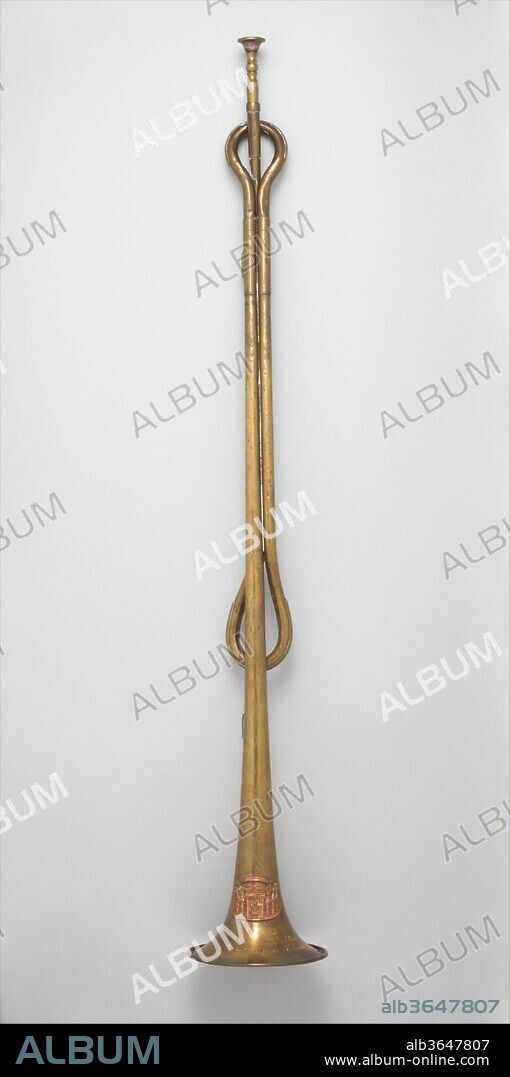alb3647807
Fanfare trumpet in E-flat

|
Añadir a otro lightbox |
|
Añadir a otro lightbox |



¿Ya tienes cuenta? Iniciar sesión
¿No tienes cuenta? Regístrate
Compra esta imagen

Título:
Fanfare trumpet in E-flat
Descripción:
Traducción automática: Trompeta de fanfarria en mi bemol. Cultura: francesa. Dimensiones: altura (sin boquilla): 32 3/8 pulgadas (82,2 cm) diámetro (de la campana): 5 5/16 pulgadas (13,5 cm). Fabricante: Adolphe (Antoine Joseph) Sax (belga, Dinant, Bélgica 1814-1894 París). Fecha: 1856. La forma de esta trompeta de desfile se inspiró en las trompetas ceremoniales de la antigua Grecia y Roma. Sax ideó inicialmente el instrumento en 1852 para su uso en L'Escadron des Cent Gardes del emperador Napoleón III. Este instrumento formaba parte de un conjunto de trompetas de desfile suministradas al castillo Wynendaele en Tourhout, Bélgica, que probablemente constaba de al menos 15 instrumentos. Otros cuatro instrumentos de este conjunto sobreviven en el Museo de Instrumentos Musicales de Bruselas. Todos estos instrumentos llevan una insignia de cobre en bajorrelieve en la campana que representa el castillo de Wynendale y tienen grabada una gran inicial M. Esto hace referencia al banquero belga Josse-Pierre Matthieu, que compró el castillo de Wynendaele en 1833 y lo restauró después de su destrucción por el Ejército Revolucionario Francés, o a su hijo Joseph Louis Matthieu, que remodeló el castillo en 1877. La trompeta de desfile del Museo Metropolitano es el único de estos instrumentos que lleva la marca AIS. La fecha de las trompetas de desfile supervivientes del conjunto Wynendaele ha sido objeto de mucha investigación. Los números de serie establecen el año de fabricación como 1856. Las trompetas formaban parte de un lote de instrumentos no vendidos que permanecieron en el stock de Sax. Posteriormente, a cada una de ellas se le ha estampado SEUL/GRAND PRIX/ 1867 para destacar el éxito de Sax en la Exposición Universal de París. La representación del castillo de Wynendaele en las campanas de estos instrumentos muestra la fachada del castillo después de que Joseph Louis Matthieu lo remodelara en una forma neogótica y romántica en 1877. Esto sugiere que el juego de trompetas se compró para conmemorar la reapertura del castillo. Los cuatro instrumentos del Museo de Instrumentos Musicales de Bruselas fueron adquiridos posteriormente por Caesar Snoeck y se describen en su Catalogue de la collection d'instruments de musique Flamands et Néerlandais formée par CC Snoeck de 1903. Se sabe poco sobre la procedencia de la trompeta de desfile donada al Museo Metropolitano. Los primeros registros indican que el estuche de este instrumento, que ya no se conserva, estaba marcado como "Ghent", lo que quizás sugiera un vínculo con Snoeck.
Fanfare trumpet in E-flat. Culture: French. Dimensions: Height (Without mouthpiece): 32 3/8 in. (82.2 cm)
Diameter (Of bell): 5 5/16 in. (13.5 cm). Maker: Adolphe (Antoine Joseph) Sax (Belgian, Dinant, Belgium 1814-1894 Paris). Date: 1856.
The form of this parade trumpet was inspired by the ceremonial trumpets of ancient Greece and Rome. Sax initially devised the instrument in 1852 for use in L'Escadron des Cent Gardes of Emperor Napoleon III.
This instrument was part of a set of parade trumpets supplied to Wynendaele Castel in Tourhout, Belgium that probably consisted of at least 15 instruments. Four other instruments from this set survive in the Musical Instruments Museum in Brussels. All of these instruments bear a bas-relief copper badge on the bell depicting Wynendale Castle and have been engraved with a large initial M. This refers to the Belgian banker Josse-Pierre Matthieu, who purchased Wynendaele Castle in 1833 and restored it after its destruction by the French Revolutionary Army, or to his son Joseph Louis Matthieu, who remodeled the castle in 1877. The parade trumpet at the Metropolitan Museum is the only one of these instruments to bear the AIS mark.
The date of the surviving parade trumpets from the Wynendaele set has been the focus of much research. The serial numbers establish the year of manufacture as 1856. The trumpets were part of a batch of unsold instruments that remained in Sax's stock. Each has been subsequently stamped SEUL/GRAND PRIX/ 1867 to note Sax's success at the Universal Exhibition in Paris. The depiction of Wynendaele Castle on the bells of these instruments shows the façade of the castle after it was remodeled in a romanticized, neo-gothic form by Joseph Louis Matthieu in 1877. This suggests that the set of trumpets was purchased to commemorate the reopening of the castle. The four instruments in the Musical Instruments Museum in Brussels were subsequently acquired by Caesar Snoeck and are described in his 1903 Catalogue de la collection d'instruments de musique Flamands et Néerlandais formée par C.C. Snoeck. Little is known of the provenance of the parade trumpet given to the Metropolitan Museum. Early records indicate that the case of this instrument, which no longer survives, was marked "Ghent", perhaps suggesting a link with Snoeck.
Técnica/material:
Latón
Museo:
Metropolitan Museum of Art, New York, USA
Productor:
Adolphe (Antoine Joseph) Sax (Belgian, Dinant, Belgium 1814-1894 Paris)
Crédito:
Album / Metropolitan Museum of Art, NY
Autorizaciones:
Modelo: No - Propiedad: No
¿Preguntas relacionadas con los derechos?
¿Preguntas relacionadas con los derechos?
Tamaño imagen:
2329 x 4672 px | 31.1 MB
Tamaño impresión:
19.7 x 39.6 cm | 7.8 x 15.6 in (300 dpi)
Palabras clave:
 Pinterest
Pinterest Twitter
Twitter Facebook
Facebook Copiar enlace
Copiar enlace Email
Email
